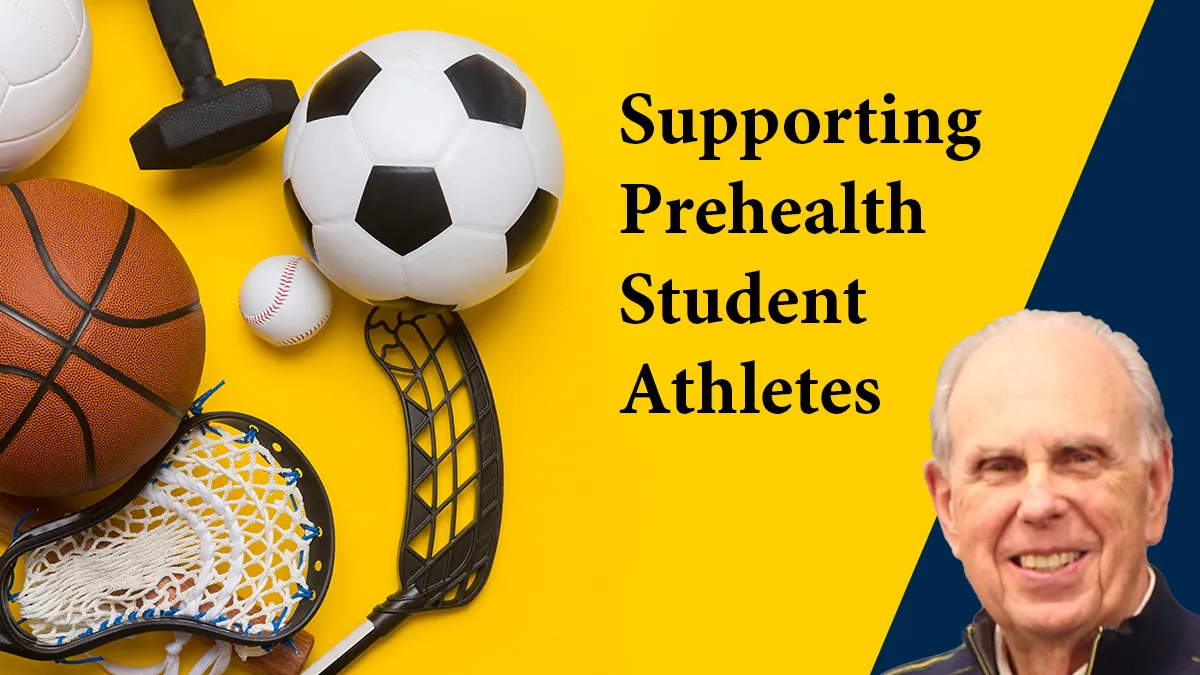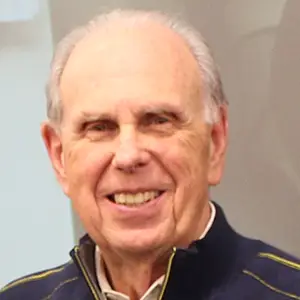Last Updated on October 16, 2024 by Laura Turner
College athletics have been in the spotlight over the last decade. Athletes can now financially benefit from name-image-likeness (NIL) agreements, and women’s athletics have grown in popularity. While a handful of athletes bask in the attention of being highly desirable future professional sports stars, most athletes grind through a rigorous, highly structured schedule that resembles military training.
Many student-athletes consider health professional careers after witnessing their own or their friends’ recoveries from injuries, including nursing, athletic training/kinesiology, physical therapy, podiatry, dentistry, veterinary medicine, and medicine. However, while athletes pursue health-related majors in a similar proportion to the general student body (NCAA Diploma Dashboards, detailed methods), fewer Division I athletes pursue STEM degrees.
A University of Michigan undergraduate and medical school alumnus who trained as an emergency physician, Dr. James Wasco has been helping student-athletes dedicated to pursuing medicine. The Health Professional Student Association named him a 2024 Advisor of the Year, and we excerpt our conversation about advising student-athletes with slight edits.
About 10 years ago, I became interested in particular groups of medical school applicants. I was also involved in a committee with the University of Michigan Athletic Department. The athletic director at the time mentioned that out of 950 student-athletes, we always have 60-70 who are interested in going to medicine. … (and wondered if I might help out)
So we started a program called “The Doctor Is In.” When I’m in Ann Arbor, I have an office in the athletic department (Michigan Athletics Career Center) where the career center staff meets with student-athletes, identify the ones who are pre-med, and then refer them to The Doctor Is In. We work with them during their four or five years in the athletic department, helping them with research opportunities, shadowing opportunities, clinical opportunities, and then with the application process and just familiarizing them with the whole field of healthcare today. When I am not in Ann Arbor, we do our mentoring work over virtual internet meeting programs.
The art of time management for prehealth student-athletes
Student-athletes’ self-discipline from following a rigorous daily routine is desirable among admissions committees and essential for success in healthcare education. However, while most prehealth/premed students thrust themselves into clinical experience and community service to build a strong application profile, student-athletes must honor other commitments.
Everyone’s journey to medical school is different. Everyone knows that getting into medical school requires an exploration not only of healthcare and your academic major or minors, but also things that you’re interested in, You want to be a balanced person when you apply to medical school.
With student-athletes, they have a unique problem… as part of their program, they have anywhere between 25 and 30 or more hours a week that have to be devoted to their athletics. Now, that’s team meetings, competitions, practices, going to the gym, and developing your physical capabilities. This limits opportunities to be involved in STEM programs and … interferes with some of the activities like volunteerism, shadowing, and research. …
As a result, the majority of our student-athletes do not apply for medical school in their junior year so that they can wind up starting medical school in the same year that they graduated. … Because of the requirements of time and energy, they don’t get a chance to fulfill all the requirements for supplemental activities. Many of them take one gap year, two gap years, sometimes even three gap years, so that they can give serious time to explore healthcare, prerequisites, shadowing, [and other] clinical experiences. We call those gap years “exploratory years,” and continue to work with them in that part of their journey as well.
Most student-athletes who aspire to a health profession like medicine, dentistry, or veterinary medicine, should plan their growth/gap years to address experience gaps and demonstrate a deeper understanding and dedication to a health professional career. This may include postbac coursework to include exposure to upper-level biomedical science-rigorous courses and dedicated time for entrance exams.
Finding support and mentorship
Many coveted high school athletes understand the importance of successful recruiting by universities they want to attend. Dr. Wasco and his mentoring team are often tapped to address concerns from students and families who aspire to pursue a health professional career.
Yes, we get involved in recruiting when I’m in the office when the university athletic department has recruiting-visit days. The coaches find out which students are interested in healthcare, interested in pre-med. … If they’re still in high school and are being recruited, we will (offer to) meet with that, prospective student-athlete and their families and maybe other people who have come with them. We explain our program that is rather unique… and that it’s a program that they are eligible for as student-athletes. …
We have a group of academic advisors in the department, and we make sure that they meet with the them as well. They learn how to access the pre-medical programs, what courses they should be interested in, what activities they should be interested in. This program is free for them; … it’s part of their scholarship or part of their just for having been an athlete there. (We also invite members of the Michigan band, the dance team, and the cheer team [who are also part of the Athletics Department family].)
We do discuss the issues with access to care that are so important around the country, particularly in the urban and rural areas where healthcare resources may be difficult to get to. We also talk about the issues of communication being very important, … that we’re a country of immigrants going back to the beginning of this country. And we stress experiences that can help them understand the special healthcare access problems that the most vulnerable in our society have – the disadvantaged and marginalized.
“The Doctor Is In” program also leverages its ability to connect professional students who were once athletes with these aspiring professionals.
[When we started our program] two years ago when we said, you know, we’ve got a group of medical students here in Ann Arbor. Many of them have been student-athletes during their academic undergraduate years. I wonder if they might help out being mentors. We sent a letter to all of the medical students to identify [if they were] undergraduate athletes and if they’re interested in working with our current [“The Doctor Is In” program] student-athletes interested in healthcare. Believe it or not, we had over 65 former student-athletes and current medical students [respond positively]. … So now when a student-athlete appears in our program, we hook them up with a mentor [in addition to] the counseling we give them in the office. That’s turned out to be very valuable because now they’re being counseled and mentored by people who very close to them in age who’ve gone through the journey not that long before them. And so they can give them great tips for how to best navigate this journey, which is quite complicated and very challenging now with the number of people applying for medical school. We call this program M.A.T.C.H. (Michigan Athletes Towards Careers in Healthcare), and it is managed by the student-athletes themselves, with our participation as needed.
Advice for the Competitive Applicant
Dr. Wasco also serves on the admissions committee for the University of Michigan Medical School. He helps screen applications and interview candidates (among whom he has not advised).
We look at the academics of STEM fields and non-STEM fields. We also look at supplemental activities like research. How much have you done? You can get into medical school without research, but if you do, you learn some additional things which are helpful for your career goals. We want to make sure they have exposure to clinical medicine, either in shadowing or we encourage them to become maybe an emergency medical technician or a certified nursing assistant, or work in a doctor’s office at a medical assistant – whatever opportunity you have to have contact with patients. …
We encourage people to find active ways of being involved clinically so that they have a chance to talk with patients. Medicine is two fields: it’s a science field and a communications field. And the more you learn about how to talk with patients, how to converse with them, how to deal with their anxieties, how to deal with sometimes their hostility, [how to] help them understand what questions they need to ask of the healthcare practitioner, and how to understand some of the complicated language. The more they’re exposed to that, the more valuable their journey as I would say. …
When [our Doctor is In students] do shadowing opportunities and volunteerism, we help them explore the barriers of care that people around the country have [faced]. One of them, of course, is language. Another one is socioeconomic factors. Another one might be transportation. Another one might be, if I can use the term, health illiteracy, particularly when it comes to preventive medicine. … [Patients] don’t really know or haven’t been educated … for what it takes to be healthy, how to stay healthy, how to do preventive measures to keep you from being exposed to communicable illnesses and other community risk factors. We … let [our students] know that, regardless of the background that they have coming from their families – whether they come from wealthy families, or they come from middle-class families, or they come from families who have struggled to make a living in this country – that they are all equal in our eyes. We will do everything to help them get the same experiences that other people do in undergraduate school so when they apply to medical school, they’re on an even footing.
My work with the student-athletes in a volunteer effort, as it is with the time in the Medical School Admissions Office. Our mentoring program has grown and includes a former Dean of the Medical School (Dr. James Woolliscroft), a PhD trained member of the Nursing Department, a dentist and physician assistant. And we have an annual conference for pre-medical student-athletes.
Watch our interview conversation
Additional reading and resources
Afualo, Drew. (2016, February 3). The Doctor Is In | Sports | manoanow.org. Ka Leo: the Voice of Hawaii.
Baker, Rachel (2019, March 20). From March Madness to medicine with help from mentors – Scope. Stanford Medicine – Scope.
Baker, Rachel. (2020, August 24). Pre-med student-athletes get mentorship, guidance from Stanford group – Scope. Stanford Medicine – Scope.
Brandon, David. (2013, December 23). Brandon’s Blog: The Doctor Is In – University of Michigan Athletics.
Doss, Will. (2020, November 20). First Year Student Tackles Medical School and College Football – News Center. Northwestern University Medicine.
Laber-Warren, Emily. (2021, September 15). To Boost Black Men in Medicine, Advocates Turn to Sports. Undark. Accessed September 9, 2024.
NFL Diversity in Sports Medicine Pipeline Initiative. National Football League. Accessed September 9, 2024.
Rockhurst University. (2022, September 9). Pre-Med Athletes’ Drive to Succeed Is Part of Their DNA | Rockhurst University.
Rizal, Rachel. (2021, September 21). How to Juggle a Premed Focus and College Sports. US News & World Report.
Scholar-athletes With Academic Goals (SWAG) Initiative. Icahn School of Medicine at Mt. Sinai. Accessed September 9, 2024.
Strowd, L. C., Gao, H., Reynolds, P., Grier, D., & Peters, T. R. (2019). Performing Under Pressure: Varsity Athletes Excel in Medical School. Medical Science Educator, 29(3), 715-720. https://doi.org/10.1007/s40670-019-00730-4.
Zahedi, Katarina. (2020). Don’t Sideline Yourself: The Pre-Medical Student Athlete. In-Training.

